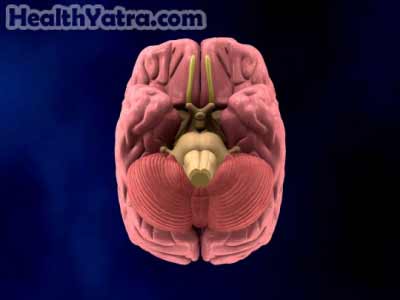Definition
Acute cerebellar ataxia is a disorder of the nervous system. It is marked by the sudden onset of a disturbance in coordination. The cerebellum is the part of the brain that plays an important role in balance and coordination. It does not function properly in the case of cerebellar ataxia.
If you suspect you or your child has this condition, call the doctor right away.

Causes
Causes of acute cerebellar ataxia include:
- Viral infections, including:
- Chickenpox
- Coxsackie disease
- Epstein-Barr virus
- Mycoplasma pneumonia
- HIV infection
- Lyme disease
- Exposure to certain toxins, such as lead, mercury, thallium, alcohol, and organophosphates found in insecticides
- Cerebellar hemorrhage, abscess, blood clot, or obstruction of an artery
- Paraneoplastic syndromes—occurs when the immune system attacks the cerebellum
Causes of recurrent or chronic acute ataxia include:
- Stroke
- Malformation of the cerebellum
- Multiple sclerosis
- Migraine or vertigo
- Genetic or metabolic disorders
- Autoimmune diseases, such as anticardiolipin antibody syndrome
- Brain tumor
- Alcoholism
- Seizures
Risk Factors
While it can occur at any age, acute cerebellar ataxia is most common in young children. It can occur several weeks after a viral infection, such as chickenpox. Most cases go away without treatment in a matter of months. However, recurrent or chronic progressive cerebellar ataxia does occur.
These factors increase the chances of developing acute cerebellar ataxia:
- Age, especially children three years of age or younger
- Viral infections
- Recent vaccination
- Exposure to certain insecticides, drugs, or toxins
Symptoms
Do not assume the following symptoms are due to acute cerebellar ataxia. These symptoms may be caused by other conditions.
- Uncoordinated movements of the limbs or trunk
- Clumsiness with daily activities
- Difficulty walking
- Speech disturbances with slurred speech and changes in tone, pitch, and volume
- Visual complaints
- Abnormal eye movements
- Accompanying symptoms may include:
- Headache
- Nausea and vomiting
- Dizziness
- Changes in mental state, such as personality or behavioral changes
- Chaotic eye movements
- Clumsy speech pattern
Diagnosis
Your doctor will ask about your symptoms and medical and family history. A physical exam will also be done. Your limb coordination will be observed to assess the degree and nature of the ataxia.
Further tests may include:
- You may need to have your bodily fluids and tissues tested. This can be done with:
- Lumbar puncture
- Blood tests
- Urine analysis
- You may need to have pictures taken of your bodily structures. This can be done with:
- MRI scan
- CT scan
- Ultrasound
- You may need to have your nerve and muscle activity tested. This can be done with:
- Nerve conduction study
- Electromyography (EMG)
Treatment
The ataxia that occurs in children can often can go away in a few months without any treatment. In cases where an underlying cause is identified, your doctor will treat the cause.
In some cases, you may have continuing and disabling symptoms. Treatment includes:
- Corticosteroids
- IV immune globulin
- Plasma exchange therapy
Drug treatment to improve muscle coordination has a low success rate. However, the following drugs may be prescribed:
- Clonazepam
- Amantadine
- Gabapentin
- Buspirone
Occupational or physical therapy may also play a role in alleviating lack of coordination. Changes to diet and nutritional supplements may also help.
Prevention
There is no way to prevent acute cerebellar ataxia except to vaccinate children against viral infections that increase their risk of getting this condition.
Acute Cerebellar Ataxia Treatment in India – Page Keywords:
Acute Cerebellar Ataxia Definition, Acute Cerebellar Ataxia Definition Causes, Acute Cerebellar Ataxia Symptoms, Acute Cerebellar Ataxia Treatment in India, Acute Cerebellar Ataxia Treatment Cost in India, Acute Cerebellar Ataxia Surgery Cost, Top Acute Cerebellar Ataxia Treatment Hospital, Top Acute Cerebellar Ataxia Treatment Doctor in India, Acute Cerebellar Ataxia Meaning in Marathi, Acute Cerebellar Ataxia Treatment Near me, Acute Cerebellar Ataxia Complications, Travel India for Acute Cerebellar Ataxia Treatment, Acute Cerebellar Ataxia Treatment in Arab Countries, Acute Cerebellar Ataxia Treatment in Bangladesh, Acute Cerebellar Ataxia Treatment in Dhaka, Acute Cerebellar Ataxia Meaning in Bengali, Acute Cerebellar Ataxia Meaning in Arabic, Acute Cerebellar Ataxia Meaning in Hindi, Acute Cerebellar Ataxia Treatment in Bahrain, Acute Cerebellar Ataxia Treatment in Egypt, Acute Cerebellar Ataxia Treatment in Iraq, Acute Cerebellar Ataxia Treatment in Jordan, Acute Cerebellar Ataxia Treatment in Kuwait, Acute Cerebellar Ataxia Treatment in Lebanon, Acute Cerebellar Ataxia Treatment in Saudi Arabia, Acute Cerebellar Ataxia Treatment in United Arab Emirates, Acute Cerebellar Ataxia Treatment in Sudan, Acute Cerebellar Ataxia Treatment in Tunisia, Acute Cerebellar Ataxia Treatment in Nepal, Acute Cerebellar Ataxia Treatment cost,
Acute Cerebellar Ataxia Treatment Cost in India, Acute Cerebellar Ataxia Top Doctors Best Hospital in India
